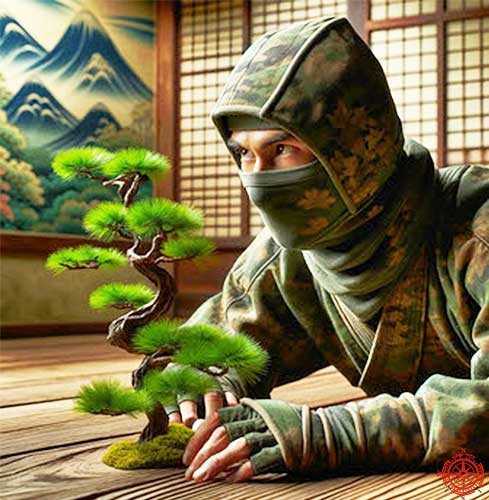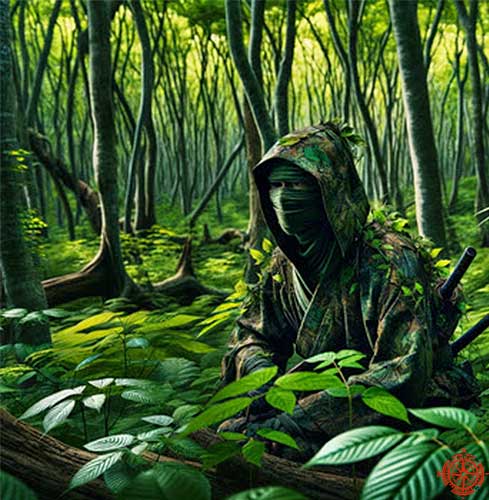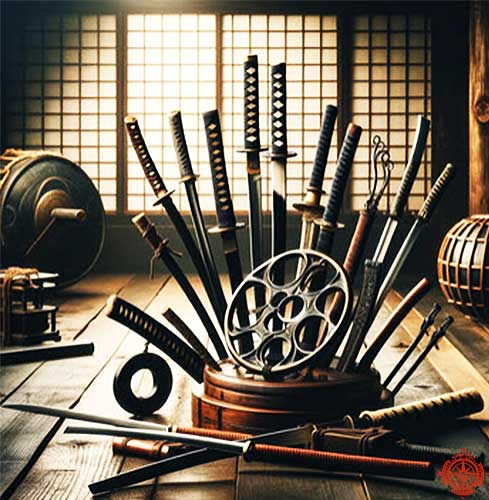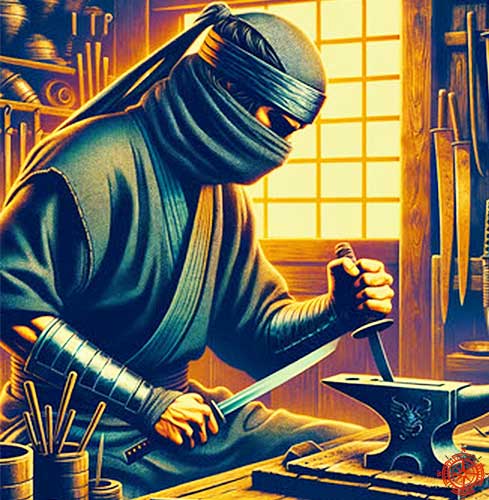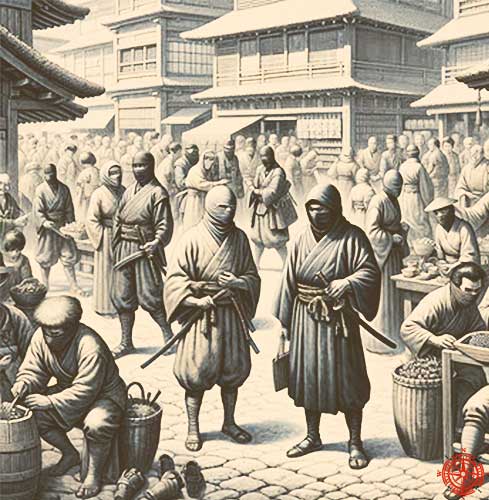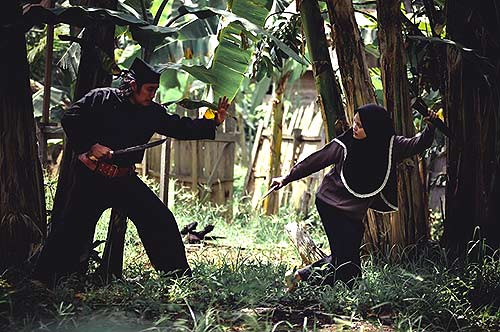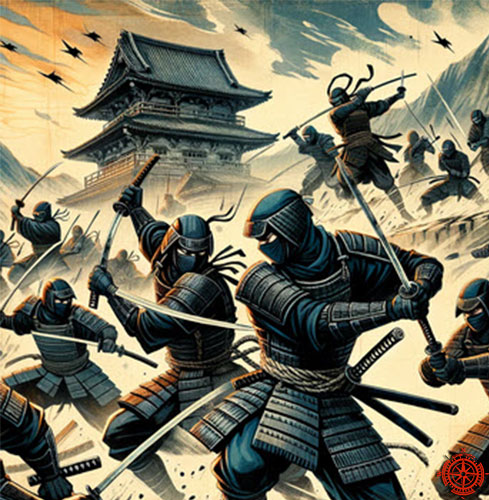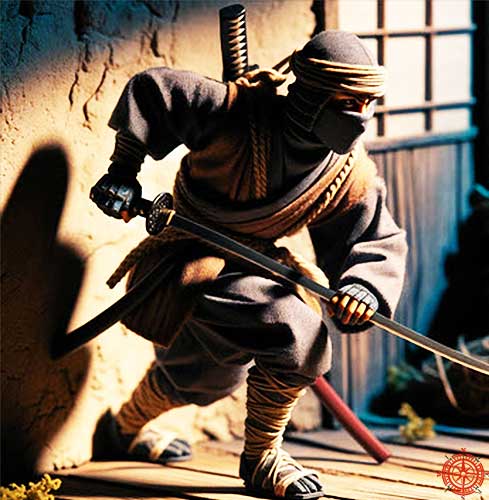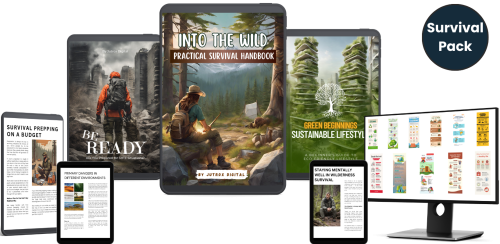- Home
- Ninja Strategies
Ninja Secret Survival Strategies
Introduction
While I have never actually trained or practiced the martial arts of the Ninjas, I have studied the Ninja secret survival strategies for several decades. I have always been fascinated with the Ninja philosophy of life and survival.
Below, I have compiled some of my collected information about how Ninja Secret Survival Strategies can be applied to our modern world, which is quickly decaying. I really hope you can appreciate and apply Ninja wisdom to your daily life.
Ancient Stealth and Camouflage Ninja Secret Survival Strategies
The ancient art of stealth and camouflage offers timeless Ninja secret survival strategies applicable to modern-day survivalists. Ninjas, known for their expertise in remaining undetected in hostile environments, mastered the skill of blending into their surroundings. This practice, pivotal in feudal Japan, remains relevant for contemporary survival situations where evasion and concealment are crucial.
A key strategy employed by Ninjas was the use of natural camouflage. This technique involved adapting to the environment by wearing colors and textures that mimicked the surroundings, thus making them nearly invisible to the enemy. Modern survivalists can adopt this strategy by using clothing and gear that blends with the natural environment, be it forest, desert, or urban settings.
Ninjas also excelled in creating diversions and using misdirection. They understood the psychological aspect of stealth, often leading adversaries to look in the wrong direction. Today, survivalists can use this tactic to distract potential threats, creating noise or movements in one area while moving stealthily in another.
Another significant aspect of Ninja Secret Survival Strategies was their exceptional situational awareness. They were trained to be acutely observant of their environment, detecting subtle changes and potential dangers. Modern survivalists can cultivate this skill by practicing heightened awareness, constantly scanning their environment and being attuned to changes, no matter how minor.
Ninjas were also skilled in the art of silent movement, a crucial element in avoiding detection. They practiced walking and moving in ways that minimized noise, an approach that modern survivalists can emulate, especially in scenarios where making noise can mean the difference between safety and danger.
Ninjas were known for their use of tools and gadgets for espionage and escape. Modern survivalists can learn from this by carrying a well-thought-out kit that includes items for camouflage, navigation, signaling, and basic survival needs.
The ancient Ninja strategies of stealth and camouflage, based on blending in, creating distractions, heightened awareness, silent movement, and effective tool usage, are as practical today for survivalists as they were centuries ago for the stealth warriors of Japan.
If you would like to know more of Ninja history, click here.
Ninja Secret Survival Strategies
Using Adaptability
Ninja adaptability strategies, deeply rooted in their historical context, are surprisingly relevant to modern-day survivalists facing varied and often hostile conditions. Ninjas were renowned for their ability to swiftly adapt to changing environments and situations, a skill crucial for survival and success in their covert missions.
One of the key elements of Ninja adaptability was their resourcefulness. Ninjas were skilled in using whatever materials were available in their environment to their advantage, whether for creating tools, weapons, or shelter. Modern survivalists can adopt this principle by learning to improvise with the resources at hand in any given situation, turning ordinary items into valuable survival tools.
Another aspect was their mental resilience and flexibility. Ninjas trained to remain calm and think clearly under pressure, adapting their strategies as situations evolved. This mental agility is vital for today's survivalists, who must be prepared to quickly reassess and adjust their plans when faced with unexpected challenges, such as changes in weather, terrain, or encountering wildlife.
Ninjas also had an extensive knowledge of various terrains and environments. They knew how to navigate forests, mountains, and urban landscapes stealthily and efficiently. Similarly, survivalists today benefit from understanding diverse environments, from mastering navigation skills in different terrains to recognizing edible plants or potential hazards.
Physical adaptability was another crucial skill for Ninjas. They trained in various martial arts and physical techniques to prepare their bodies for any challenge. Modern survivalists can take a cue from this by maintaining physical fitness and learning skills like swimming, climbing, and trekking, ensuring they are prepared for any physical challenges they might encounter.
Ninjas were masters of disguise and blending in. This ability to adapt their appearance according to the environment helped them avoid detection. In contemporary survival scenarios, learning to blend into one's surroundings, whether in a natural or urban setting, can be a significant advantage, especially in evasion or stealth situations.
The Ninja's adaptability in resource use, mental resilience, knowledge of environments, physical preparedness, and disguise offer valuable lessons for current day survivalists in mastering the art of survival in hostile and unpredictable conditions.
Ninja Secret Survival Strategies
for Using Resourcefulness
The principle of Ninja resourcefulness, an essential aspect of their survival strategy, holds significant relevance for modern-day survivalists. Historically, Ninjas were adept at improvising tools and weapons from everyday materials, demonstrating an exceptional ability to adapt to their environment using limited resources. This concept is particularly valuable in contemporary survival scenarios, where adaptability can mean the difference between life and death.
Firstly, the Ninja's ability to use their environment creatively can be mirrored in modern survival practices. For instance, Ninjas might have used stones and branches for weapons or tools, a practice modern survivalists can emulate by learning to utilize natural elements around them for shelter, tools, or even self-defense.
Secondly, the Ninja's ingenuity in making the most out of seemingly mundane objects can teach modern survivalists the importance of seeing beyond the conventional uses of items. For example, a simple piece of cloth could serve multiple purposes: as a bandage, a water filter, or a signaling device. This multi-use approach to resources is critical in situations where carrying a lot of gear is not feasible.
Another key lesson from Ninja Secret Survival Strategies is the importance of mental agility. Ninjas were not just physically adept but also mentally sharp, capable of quickly devising solutions in challenging situations. Modern survivalists should cultivate this mental flexibility to think quickly and creatively when faced with unexpected challenges.
Ninjas were known for their minimalist approach, carrying only what was essential. This principle is vital in modern survival, emphasizing the importance of a well-thought-out survival kit that is both lightweight and versatile, containing items that serve multiple purposes.
Ninjas often used their knowledge of chemistry and the natural world to their advantage, creating distractions or defenses. Modern survivalists can learn from this by understanding basic principles of science and nature, such as knowing which plants are medicinal or how to create simple chemical reactions for various purposes.
In essence, the Ninja's resourcefulness, characterized by creative use of the environment, versatility in employing everyday items, mental agility, minimalism, and understanding of nature, offers a timeless guide for modern survivalists in adapting and thriving in hostile conditions.
Ninja Secret Survival Strategies
Using Physical and Mental
Endurance
The ancient Ninja's training in physical and mental endurance offers valuable insights for modern-day survivalists. Ninjas were renowned for their rigorous training regimes, equipping them with the resilience needed to endure physically demanding and psychologically taxing situations. This level of endurance is a critical aspect of survival that contemporary survival enthusiasts can learn from.
First and foremost, physical endurance was a cornerstone of Ninja training. They engaged in strenuous physical activities to build stamina, strength, and agility, all of which are vital for surviving in harsh conditions. Modern survivalists can emulate this by incorporating regular physical training into their routines, focusing on cardiovascular fitness, strength training, and flexibility exercises. This physical preparedness is crucial, especially in situations that require long treks, carrying heavy loads, or overcoming physical obstacles.
Mental fortitude was equally important in the life of a Ninja. They were trained to maintain composure and make rational decisions under stress, a skill imperative for survival. Today's survivalists can develop this mental endurance by practicing stress management techniques, such as meditation or tactical breathing, and by putting themselves in challenging situations during training to build mental toughness.
Ninjas also practiced situational awareness and quick thinking, essential for navigating dangerous and unpredictable environments. Modern survival enthusiasts should hone their observational skills and learn to quickly assess and adapt to changing conditions, whether in the wilderness or urban settings.
Furthermore, the Ninja's endurance was not just about physical and mental strength but also about resilience and adaptability. They were skilled in surviving with minimal resources, an approach today's survivalists can adopt by learning to use available resources efficiently and improvising solutions in resource-scarce situations.
The Ninja's training in physical endurance, mental fortitude, situational awareness, and adaptability offers a comprehensive framework for modern survivalists. By embracing these principles, one can develop the necessary skills to withstand and thrive in a variety of challenging survival scenarios.
Ninja Secret Survival Strategies
for Using Escape and Evasion Techniques
The ancient art of Ninja escape and evasion is an intriguing and applicable subject for modern-day survivalists. Historically, Ninjas were experts in avoiding capture and escaping from various forms of confinement, a skill set that directly translates to survival situations where evading danger or escaping from a perilous scenario is necessary.
One of the key aspects of Ninja escape and evasion techniques was their deep understanding of their environment. Ninjas were adept at using the natural terrain to their advantage, blending into their surroundings to become virtually invisible. Modern survivalists can apply this principle by mastering the skills of camouflage and stealth movement in various environments, be it in a forest, an urban landscape, or a mountainous area.
Ninjas also had a profound knowledge of human psychology and behavior, which they used to outsmart their adversaries. This knowledge can be translated into understanding potential threats in modern scenarios, like identifying the behavior of predators (both human and animal) and using diversion tactics to evade them.
Additionally, Ninjas were trained in various physical techniques like climbing, swimming, and quick, agile movements, which enhanced their ability to escape swiftly. These physical skills are equally vital for survivalists, who should maintain a high level of physical fitness and acquire skills like climbing, swimming, and navigating difficult terrains to increase their chances of evasion and escape in emergencies.
The Ninjas' use of tools and gadgets, often improvised, was another facet of their escape and evasion expertise. Learning to use and improvise with whatever tools are available can be a life-saving skill for survivalists, whether it's using a simple rope for climbing, creating distractions, or improvising signaling devices for rescue.
The Ninja techniques of understanding and utilizing the environment, psychological and behavioral awareness, physical agility and skill, and the innovative use of tools provide a comprehensive framework for modern survivalists. These skills, when mastered and adapted to contemporary scenarios, can significantly enhance one's ability to evade and escape dangerous situations.
Ninja Secret Survival Strategies for Using Their Knowledge of
Medicine and Poison
The ancient knowledge of medicine and poisons, integral to the Ninja's skill set, offers valuable lessons for modern-day survivalists. Ninjas were adept at using natural resources for healing as well as for creating poisons, a dual skill that could be lifesaving in survival scenarios.
First off, the Ninja's proficiency in identifying and using medicinal herbs is particularly relevant. They knew how to treat wounds, alleviate pain, and manage illnesses using plants available in their environment. Modern survivalists can benefit from acquiring similar knowledge about local flora, understanding which plants have medicinal properties, and learning the proper ways to prepare and use them. This skill is especially crucial in situations where conventional medical help is not accessible.
In addition to healing, Ninjas were skilled in the use of poisons, extracted from plants, animals, or minerals. While the use of poisons may not directly correlate to modern survival practices, the underlying principle of understanding the toxic properties of certain natural elements is important. This knowledge can help survivalists avoid poisonous plants or animals and can be critical in navigating environments where such hazards are present.
The Ninja's understanding of medicine and poisons was not only practical but also deeply rooted in their strategic thinking. They used this knowledge to gain advantages in their missions. Similarly, survivalists must think strategically when it comes to managing health risks and hazards in the wilderness, whether it's avoiding toxic substances or using medicinal plants to maintain health.
The Ninja's approach was holistic, combining their knowledge of medicine with physical and mental wellness practices. Modern survivalists can adopt this holistic approach, understanding that maintaining health in a survival situation involves a balance of physical well-being, mental resilience, and practical knowledge.
The Ninja's expertise in medicinal herbs and poisons provides a comprehensive framework for modern survivalists. By learning to identify and use medicinal plants, understanding the dangers of natural toxins, thinking strategically about health and safety, and adopting a holistic approach to wellness, survivalists can enhance their ability to thrive in challenging conditions.
Secret Survival Strategies for Ancient Ninjas Using Tactical Planning and Strategy
The art of Ninja tactical planning and strategy, central to their successful missions in feudal Japan, offers invaluable lessons for contemporary survivalists. Ninjas were renowned for their meticulous planning, emphasizing the importance of both strategic foresight and tactical preparation, principles that are equally vital in modern survival scenarios.
Strategic planning in the Ninja context involved long-term vision and objectives. They would consider the broader picture, set goals, and develop plans to achieve them, often involving elaborate schemes and contingencies. This mirrors the need for modern survivalists to have a clear understanding of their long-term survival goals, whether preparing for natural disasters, societal breakdowns, or wilderness survival. This includes having a well-thought-out plan for food storage, shelter, water supply, and security.
Tactical planning, on the other hand, was about the specific actions and maneuvers Ninjas would undertake to accomplish their strategic objectives. This included choosing the right tools, mapping out routes, and planning for various contingencies. Similarly, modern survivalists need to focus on the day-to-day tactics of survival, such as the skills needed to build a shelter, find food, navigate terrain, or handle emergency situations.
One significant aspect of Ninja planning was adaptability. They were prepared to change tactics as situations evolved. This adaptability is crucial for survivalists, as survival situations are often unpredictable, requiring the ability to quickly adjust plans and tactics in response to changing conditions.
Ninjas placed a strong emphasis on intelligence gathering and knowledge. They would extensively research their targets and environments before acting. This principle applies to survivalists who must stay informed about their surroundings, potential threats, and available resources.
The Ninja's blend of strategic foresight and tactical proficiency provides a comprehensive model for survivalists. By integrating long-term planning with adaptable, well-informed tactical approaches, survivalists can enhance their preparedness and increase their chances of thriving in any survival scenario.
Secret Survival Strategies for Ancient Ninjas Using Disguise and
Impersonation
The ancient Ninja technique of disguise and impersonation, crucial for their espionage and infiltration missions, holds significant relevance for modern-day survivalists, particularly in urban or hostile environments. This art of blending in and gathering information without attracting attention can be a critical skill in various survival scenarios.
Ninjas mastered the art of disguise, often adopting the appearance of common folk or even enemy personnel to avoid detection. They understood the importance of not just physical disguise but also mimicking mannerisms and behaviors to convincingly blend in. Modern survivalists can apply these principles in situations where anonymity is key, such as moving through populated areas during times of unrest or in hostile territories. Adopting a nondescript appearance and understanding cultural or social norms of the area can help in avoiding unwanted attention.
Impersonation, another facet of their skill set, involved adopting roles that allowed Ninjas to access restricted areas or gather intelligence. For survivalists, this could translate into understanding how to interact in various social situations or how to convincingly assume a role that enables safer passage or access to resources in a crisis.
Ninjas were adept at reading social cues and understanding the psychology of those around them. This level of social awareness is invaluable for survivalists, enabling them to assess intentions, identify threats, and navigate complex social landscapes effectively.
In addition to blending in, these techniques also involved a keen sense of observation. Ninjas were not just hidden; they were attuned to their surroundings, gathering crucial information while remaining undetected. Similarly, survivalists must develop sharp observation skills to gather information about resources, potential dangers, and escape routes in populated or hostile environments.
The Ninja's expertise in disguise and impersonation can be adapted by modern survivalists to enhance their ability to navigate through challenging environments discreetly. By mastering the art of blending in, understanding social dynamics, and remaining observant, survivalists can significantly improve their chances of success in various survival situations.
Conclusions
We'll dive even deeper into what you have seen and read on this page. Please continue to click through to more of my pages to discover even more hidden or little-known secrets.
Be sure to check out the "vital details" of our new
Survival Intelligence Blackfile.

